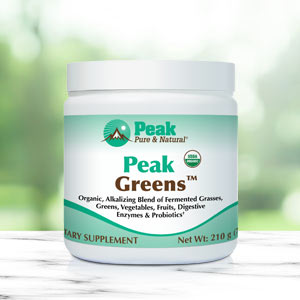Get Easy Health Digest™ in your inbox and don’t miss a thing when you subscribe today. Plus, get the free bonus report, Mother Nature’s Tips, Tricks and Remedies for Cholesterol, Blood Pressure & Blood Sugar as my way of saying welcome to the community!
Is acid slowly eroding your health?

Diet is one of the single most important factors in health and healing. As we know, the Western diet places heavy emphasis on concentrated animal proteins and processed, grain-derived carbohydrates which have a relatively low nutritional value.
This way of eating is sometimes referred to as the Standard American Diet (SAD), and produces a chronic low-grade, overly-acid state in the body, according to many well-documented studies. By understanding the impact your diet has on your overall health in terms of pH balance, you will see that an alkalizing diet can offer numerous benefits both immediately, as well as for long-term wellness and vitality.
Acid/alkaline levels in the body
The body, in its wondrous intelligence, maintains very specific acid/alkaline levels in its various organs, tissues and fluids:
- Blood: 7.35-7.45 pH
- Muscle: 6.1 pH
- Liver: 6.9 pH
- Gastric juice: 1.2-3.0 pH
- Saliva: 6.35-6.85 pH
- Urine: 4.5-8.0 pH
- Pancreatic juice: 7.8-8.0 pH
Many of the body’s key systems and organs including the kidneys, lungs, bones and others have “homeostatic” mechanisms in place to respond to pH changes and readjust alkaline/acid levels as needed. A chronically acidic state can tax these homeostatic mechanisms which work hard to keep our systems in balance.
Over acidity compromises health over time and contributes to a number of chronic degenerative conditions such as gastrointestinal issues, osteoporosis, kidney disease, muscle wasting, and many others. For example, bone is called upon repeatedly to help buffer an over acidic environment, and thus becomes de-mineralized because the alkaline minerals calcium and magnesium are continuously removed from the bone to help the body adjust acidity back toward a more alkaline state. Increased calcium excretion from bone can also increase the risk of kidney stones, another detrimental effect.
What exactly is “pH”?
This term refers to the “potential of hydrogen.” Hydrogen ions contribute acidity to any tissue or organ, such as the contribution of hydrochloric acid to the high acidity of stomach secretions.
The scale used to measure pH is a logarithmic scale, which means that there is a 10-fold difference between each number -ranging from 1 to 14. The lower numbers (1-6.99) represent the acid (or H+ donating) range and the higher numbers (7.01-14) represent the alkaline (or H+ accepting) range. Neutral is “7.0.” Some body systems such as the blood (7.35-7.45) are more tightly regulated than others. Urine has a broader pH range, from 4.5-8.0, which makes it an ideal body fluid for keeping track of adjustments in pH with dietary modifications.
Factors that affect pH levels
Food intake is one of the primary ways that pH is influenced. Dietary modifications can positively influence pH values within various systems of the body, and therefore positively influence the health of the organs that work so hard to maintain pH values within their optimal ranges.
For example, a high intake of vegetables, which are for the most part alkalinizing, will neutralize over-acidity and result in a positive influence on bone metabolism, increasing the retention of phosphates and calcium, while reducing markers of bone resorption.
Most fruits for example are acid forming, with the exception of a few such as lemons and limes. Lemons and limes certainly have acidic properties, but are actually alkalizing once digested, which is why these fruits are so highly recommended during a seasonal cleanse or detoxification program.
The following guidelines can tell you whether a particular food is more acid forming, or more alkaline forming.
Highly alkaline foods
Himalayan salt
Grasses
Cucumber
Kale
Kelp
Spinach
Parsley
Broccoli
Sprouts (soy, alfalfa etc)
Sea Vegetables (Kelp)
Green drinks
Sprouts
Moderately alkaline foods
Avocado
Beetroot
Butter Beans
Capsicum/Pepper
Cabbage
Celery
Chia/Salba seeds
Collard/Spring Greens
Endive
Garlic
Ginger
Green Beans
Lettuce
Lemon
Lime
Mustard Greens
Okra
Onion
Radish
Red Onion
Quinoa
Rocket/Arugula
Soy Beans
Tomato
White Haricot Beans
Mildly alkaline foods
Artichokes
Asparagus
Brussels sprouts
Cauliflower
Carrot
Chives
Courgette/Zucchini
Leeks
New Red Potatoes
Peas
Rhubarb
Swede
Watercress
Buckwheat
Spelt
Lentils
Tofu
Almond mild
Most herbs and spices
Olive oil
Coconut oil
Flax oil
Mildly acidic foods
Black beans
Kidney beans
Garbanzo beans
Cantaloupe
Currents
Dates
Nectarine
Plum
Cherry
Amaranth
Millet
Oats
Spelt
Rice, soy, hemp protein
Freshwater wild fish
Brazil, pecan and hazelnuts
Moderately acidic foods
Apple
Apricot
Banana
Blackberry
Butter
Cranberry
Grape
Mango
Peach
Orange
Papaya
Pineapple
Strawberry
Brown rice
Wheat
Wild rice
Ocean fish
Highly acidic foods
Alcohol
Over-the-counter and Rx drugs
Coffee, tea
Cocoa
Sugars and sweeteners
Dried fruit
Beef
Chicken
Eggs
Farmed fish
Pork
Shellfish
Cheese
Most dairy (except raw dairy which can be slightly alkalizing)
Mushroom













